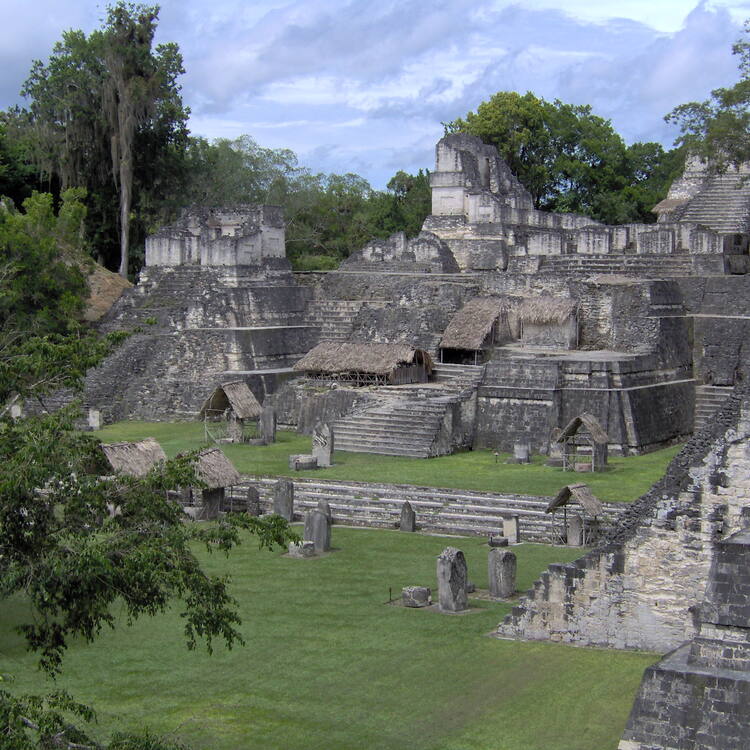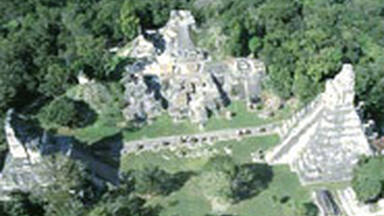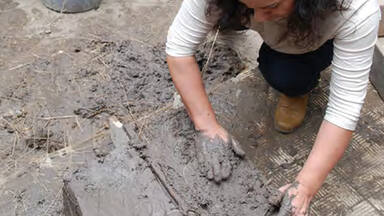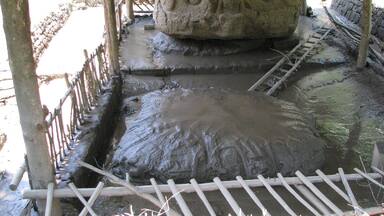Tikal National Park
Tikal National Park
In the heart of the jungle, surrounded by lush vegetation, lies one of the major sites of Mayan civilization, inhabited from the 6th century B.C. to the 10th century A.D. The ceremonial centre contains superb temples and palaces, and public squares accessed by means of ramps. Remains of dwellings are scattered throughout the surrounding countryside.
Description is available under license CC-BY-SA IGO 3.0
Parc national de Tikal
Au cœur de la jungle, dans une végétation luxuriante, Tikal est l'un des sites majeurs de la civilisation maya qui fut habité du VIe siècle av. J.-C. au Xe siècle de l'ère chrétienne. Son centre cérémoniel comporte de superbes temples et palais et des places publiques auxquelles on accède par des rampes. Des vestiges d'habitations sont disséminés dans la campagne avoisinante.
Description is available under license CC-BY-SA IGO 3.0
منتزه تكال الوطني
يُعتبر منتزه تكال الذي يقع في قلب الغابة والمُحاط بالنباتات المعشبة أحد أهم مواقع حضارة المايا المأهولة من القرن السادس قبل الميلاد حتى القرن العاشر من الحقبة المسيحية. ويشمل مركزه الاحتفالي معابد خلابة وقصوراً وأماكن عامة يمكن بلوغها عبر قناطر مشاة. وفي الريف المجاور آثار لمساكن بشرية قديمة.
source: UNESCO/CPE
Description is available under license CC-BY-SA IGO 3.0
蒂卡尔国家公园
在丛林心脏地带的繁茂植被环绕下,坐落着玛雅文明的主要遗址之一。自公元前6世纪到公元10世纪,这里一直有人居住。作为一个举行仪式的场所,这里不但有华丽而庄严的庙宇和宫殿,也有公共的广场,可沿坡道进入。周围的乡村内还零散保留着一些民居的遗迹。
source: UNESCO/CPE
Description is available under license CC-BY-SA IGO 3.0
Национальный парк Тикаль
В самом сердце джунглей в окружении пышной растительности находится один из главных центров цивилизации майя, который был обитаем в период VI в. до н.э. – X в. н.э. Ритуальный центр этого города составляют внушительные храмы и дворцы, большие площади, для доступа на которые были сооружены специальные пандусы. На окружающей их территории сохранились остатки жилых построек.
source: UNESCO/CPE
Description is available under license CC-BY-SA IGO 3.0
Parque Nacional Tikal
Situado en el corazón de una selva de vegetación lujuriante, Tikal es uno de los sitios más importantes de la civilización maya. Fue habitado desde el siglo VI a.C. hasta el siglo X d.C. Su centro ceremonial comprende templos y palacios soberbios, así como plazas públicas a las que se accedía por rampas. En sus alrededores hay vestigios diseminados de viviendas.
source: UNESCO/CPE
Description is available under license CC-BY-SA IGO 3.0
ティカル国立公園
source: NFUAJ
Nationaal park Tikal
Source: unesco.nl
Outstanding Universal Value
Brief synthesis
Tikal National Park is located in Northern Guatemala's Petén Province within a large forest region often referred to as the Maya Forest, which extends into neighbouring Mexico and Belize. Embedded within the much larger Maya Biosphere Reserve, exceeding two million hectares and contiguous with additional conservation areas, Tikal National Park is one of the few World Heritage properties inscribed according to both natural and cultural criteria for its extraordinary biodiversity and archaeological importance. It comprises 57,600 hectares of wetlands, savannah, tropical broadleaf and palm forests with thousands of architectural and artistic remains of the Mayan civilization from the Preclassic Period (600 BC) to the decline and eventual collapse of the urban centre around 900 AD. The diverse ecosystems and habitats harbour a wide spectrum of neotropical fauna and flora. Five cats, including Jaguar and Puma, several species of monkeys and anteaters and more than 300 species of birds are among the notable wildlife. The forests comprise more than 200 tree species and over 2000 higher plants have been recorded across the diverse habitats.
Tikal, a major Pre-Columbian political, economic and military centre, is one of the most important archaeological complexes left by the Maya civilization. An inner urban zone of around 400 hectares contains the principal monumental architecture and monuments which include palaces, temples, ceremonial platforms, small and medium sized residences, ball-game courts, terraces, roads, large and small squares. Many of the existing monuments preserve decorated surfaces, including stone carvings and mural paintings with hieroglyphic inscriptions, which illustrate the dynastic history of the city and its relationships with urban centres as far away as Teotihuacan and Calakmul in Mexico, Copan in Honduras or Caracol in Belize. A wider zone of key archaeological importance, around 1,200 hectares, covers residential areas and historic water reservoirs, today known as “aguadas”. The extensive peripheral zone features more than 25 associated secondary sites, historically serving protective purposes and as check-points for trade routes. The peripheral areas also played a major role for agricultural production for the densely populated centre.
Research has revealed numerous constructions, carved monuments and other evidence bearing witness to highly sophisticated technical, intellectual and artistic achievements that developed from the arrival of the first settlers (800 BC) to the last stages of historic occupation around the year 900. Tikal has enhanced our understanding not only of an extraordinary bygone civilisation but also of cultural evolution more broadly. The diversity and quality of architectonical and sculptural ensembles serving ceremonial, administrative and residential functions are exemplified in a number of exceptional places, such as the Great Plaza, the Lost World Complex, the Twin Pyramid Complexes, as well as in ball courts and irrigation structures.
Criterion (i): Tikal National Park is an outstanding example of the art and human genius of the Maya. Its wealth of architectural and artistic expressions also contains important symbolic elements, such as the concept of pyramid-as mountains that define a universe where human beings coexisted with their environment. It is also an exceptional place of cosmological connotations and was considered to have been a “stage” for theatrical representations.
Criterion (iii): Tikal National Park has unique elements that illustrate the historic, mythical and biographic data of the Tikal dynastic sequence. These exceptional records span over 1,161 years (292 BC to 869 AD) and register the lives of 33 rulers who reigned over a vast territory of the ancient Maya world. The earliest stone sculpture is Stela 29 dated to the year 292 and the last monument sculptured is Stela 11 dated to the year 869.
Criterion (iv): The archaeological remains at Tikal National Park reflect the cultural evolution of Mayan society from hunter-gathering to farming, with an elaborate religious, artistic and scientific culture. The most representative remains show different stages and degrees of evolution in terms of architectural development related to religious activities and ceremonies. They also exemplify the political, social and economic organization achieved, as expressed by the urban layout its palaces, temples, ceremonial platforms, and residential areas and the wealth of monuments decorated with hieroglyphic inscriptions.
Criterion (ix): The landscape mosaic comprising savannas, lush forests, wetlands and various freshwater systems is part of the Maya Forest, one of the conservation gems of Central America, hosting a rich diversity of flora and fauna as a result of a remarkable evolution of species and ecological communities. The seemingly pristine ecosystems represent an impressive natural recovery after historic conversion and intensive land and resource use during the many centuries as one of the centres of the Mayan civilisation. The ongoing biological and ecological processes are supported and protected by the large scale of the Maya Forest, and particularly its many conservation areas.
Criterion (x): The Petén Region and the Maya Forest are home to an impressive diversity of flora and fauna across its various terrestrial and freshwater habitats. More than 2000 higher plants, including 200 tree species have been inventoried. Palms, epiphytes, orchids and bromeliads abound in the various forest types. The more than 100 mammals include over 60 species of bat, five species of felids - Jaguar, Puma, Ocelot, Margay and Jaguarundi, as well as Mantled Howler Monkey and many endangered species such as Yucatan Spider Monkey and Baird's Tapir. The more than 330 recorded bird species include the near-threatened Ocellated Turkey, Crested Eagle and Ornate Hawk-Eagle, as well as the vulnerable Great Curassow. Of the more than 100 reptiles the endangered Central American River Turtle, Morelet's Crocodile and 38 species of snakes stand out. In addition to 25 known amphibian species, there is a noteworthy fish fauna and a great diversity of invertebrates. The property is also known for wild varieties of several important agricultural plants.
Integrity
The 57,600 hectares protected as a national park provide an umbrella for the conservation of the magnificent archaeological remains of a major centre of the Maya civilisation. Even though the boundaries of the National Park, identical to the property in its extension, have been defined primarily based on the location of the main archaeological features, they cover a notable array of highly valuable habitat for countless species of flora and fauna. Since the days of the nomination of the property, there have been intentions to consider additional adjacent forest areas to be covered by a possible extension of the property, which would no doubt consolidate the integrity of the property from a nature conservation perspective. This extension would also be crucial to ensure the protection of archaeological remains which are currently outside the property’s boundaries and which are essential attributes to the understanding of the long-term evolution of Tikal as a whole. In addition, even though the boundaries of the properties include all the cultural attributes necessary to express its outstanding universal value, several factors have contributed to the erosion of the material integrity of the property. Among these, weathering and illegal looting practices are critical issues that need to be addressed comprehensively. There are significant technical and material challenges in preserving the vast amounts of remains in a wet, tropical climate, so sustained and holistic measures are needed to ensure the long-term conservation of a large part of the cultural heritage present at the property.
Authenticity
The conditions of authenticity at Tikal National Park have been largely maintained in the property in terms of location and setting as the surroundings of the site have been retained. In terms of form and design, the historical integration of architecture with the geographic setting is still evident and the urban layout is still clearly discernible. There are significant archaeological elements that remain untouched until today which provide evidence of the authentic materials and construction techniques. Notwithstanding, in the past there were a large number of conservation and restoration projects at the main architectural complexes which eroded to a certain degree the authenticity of the remains given the extent of the restoration interventions and the materials used for the interventions. On-going conservation practices have focused largely on addressing the effects of natural factors, such as weathering and vegetation growth, as well as human ones including looting. A stronger emphasis has been placed on carrying out interventions which maintain the qualities of the original materials and techniques. These practices will need to be sustained to ensure the material integrity of the remains but avoiding large restoration projects, so there is minimal impact on the conditions of authenticity. To continue with traditional construction practices, the use of locally available material, of traditional knowledge systems and of skilled craftsmanship will also be important. Another factor that can potential hinder the authenticity of the property is related to the pressures derived from touristic use, which will entail the development and enforcement of strong protection and regulatory measures in terms of development of facilities and infrastructure to maintain the authenticity of the setting.
Protection and management requirements
Tikal was declared a national monument in 1931 and a national park in 1955, one of Guatemala's first protected areas. Two years later, the boundaries and regulations were refined. More recently, in 1990, the vast Maya Forest Biosphere Reserve was recognised by UNESCO with the property being one of several core zones. This provides an opportunity to address the management and conservation of the Guatemalan part of the Maya Forest and its extraordinary cultural heritage at a landscape level, provided that the good intentions are followed up by adequate political support, funding, staffing and effective management. To the degree possible, cooperation with the neighbouring countries of Belize and Mexico is also highly desirable; both have established important conservation areas in their respective parts of the forest region. Management and conservation is strategically guided by a Master Plan. One challenge is to coordinate the involved sectors and to integrate the needs for cultural and natural heritage in one document, approach and process. An administrator and a technical team are in charge of the management which focuses on archaeology, nature conservation, environmental education, community relationships and public use. Armed guards are in charge of law enforcement, jointly with a specialised tourism police force.
Looting of archaeological remains has been occurring in the property, indicating a need for stronger control and enforcement of legislative and regulatory measures. This need appears to be even stronger when it comes to natural values, as a much larger and more remote area is concerned. The strong population increase in this part of Guatemala in recent decades in a rural resource-dependent setting inevitably creates challenges. Villages and farmland are closing in on the property, in particular near the Southern border. The rich and diverse forest resources have always been strongly used by local communities. Gathering, hunting and fishing are common activities, as is livestock keeping and associated burning of grazing areas. Ongoing negotiation is needed between the site managers, other governmental institutions and local communities to find mutually acceptable forms of natural resource management. Tourism, modest at the time of inscription, has reached a level of mass tourism during seasonal peaks with annual visitor numbers in the hundreds of thousands. Tourism is a major management issue risking serious damage to the most visited sites. Concrete impacts include problems with solid waste and wastewater, as well as impacts on the archaeological remains from physical erosion and vandalism, requiring careful assessments and management responses. At the same time, tourism is a significant factor in the local economy with a major potential to contribute to education and conservation funding, complementing governmental budgets and external support from research and conservation institutions.




